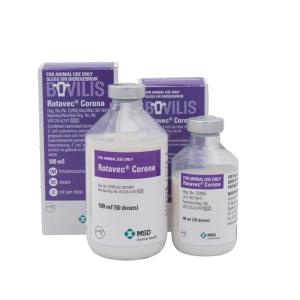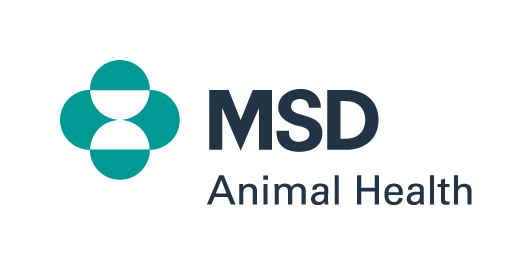Rotavec® Corona
For the active immunisation of pregnant cows and heifers to raise antibodies against E. coli adhesion E5 (K99) antigen, rotavirus and coronavirus. These antibodies protect calves against these diseases.

FOR ANIMAL USE ONLY
ROTAVEC® CORONA
Reg. No. G2955 (Act 36/1947)
Namibia Reg. No. V07/24.4/747 [NS0]
Emulsion for injection
Only for use by or under the supervision of persons registered in terms of, or authorised in terms of, Section 23 (1) (c) of the Veterinary and Para-Veterinary Professions Act, 1982 (Act 19 of 1982).
INDICATIONS
For the active immunisation of pregnant cows and heifers to raise antibodies against E. coli adhesins F5 (K99) and F41, rotavirus and coronavirus. While calves are fed colostrum from vaccinated cows during the first 2 to 4 weeks of life, these antibodies have been demonstrated to:
- Reduce the severity of diarrhoea caused by E. coli.
- Reduce the incidence of scours caused by rotavirus.
- Reduce the shedding of virus by calves infected with rotavirus or coronavirus.
Onset of Immunity: Passive protection against all active substances will commence from the start of colostrum feeding.
Duration of Immunity: In calves artificially fed with colostrum, protection will continue until colostrum feeding ceases. In naturally suckled calves, protection against rotavirus will persist for at least 7 days and against coronavirus for at least 14 days.
COMPOSITION
Each 2 mℓ contains:
Bovine rotavirus strain UK-Compton, serotype G6 P5 (inactivated) ≥ 874 U1
Bovine coronavirus, strain Mebus (inactivated) ≥ 340 U1
E. coli strain CN7985 (K99+:F41+) ≥ 560 U1
Adjuvant: aluminium hydroxide and light mineral oil/emulsifier.
Preservative: thiomersal ≤ 0,069 mg
1 Units as determined in the in-vitro potency tests
STORAGE INSTRUCTIONS
- Store between 2 °C – 8 °C in a refrigerator.
- Do not freeze.
- Protect from sunlight.
- In-use shelf life: 28 days after the vial is first opened.
WARNINGS
- Withdrawal period: Do not slaughter cattle for human consumption within 21 days after vaccination.
- Vaccinate healthy pregnant cows and heifers only.
- Do not mix Rotavec® Corona with any other veterinary medicinal product.
- No information is available on the concurrent use of Rotavec® Corona with any other vaccines. It is therefore recommended that no other vaccine should be administered within 14 days before or after vaccination with Rotavec® Corona.
- Do not over- or under-dose.
- As with all inactivated vaccines, small swellings may appear at the injection site. This should resolve after 2-3 weeks. If not, or if any inflammation is evident, consult the veterinarian.
- Handle all pregnant animals to be vaccinated with care and create a non-stressful environment.
- KEEP OUT OF REACH OF CHILDREN, UNINFORMED PERSONS AND ANIMALS.
- Although this vaccine has been extensively tested under a large variety of conditions, failure thereof may ensue as a result of a wide range of reasons. If this is suspected, seek veterinary advice and notify the registration holder.
PRECAUTIONS
- Observe aseptic precautions. Ensure that all vaccination equipment (containers, syringes and needles) is clean and sterile prior to and during use. Use sterile equipment when administering the vaccine.
- Do not use disinfectants or antiseptics to sterilise any equipment.
- It is good vaccination practice when handling the vaccine to avoid contact with the eyes, hands and clothing. Wear protective clothing and equipment in line with safety requirements and regulations.
- Destroy any unused vaccine and dispose of all the empty vaccine containers and disposable equipment after use in accordance with National Environmental Management: Waste Act, 2008 (Act No. 59 of 2008).
- Due to the adjuvant used, local reactions may occur in some animals at the injection site. It will disappear after a few days.
- Do not contaminate rivers, dams or any water sources with containers or waste.
Special precautions to be taken by the person administering Rotavec® Corona to animals.
To the user:
Rotavec® Corona contains mineral oil. If you are accidentally injected with vaccine, seek prompt medical advice even if only a very small amount is injected and take the package insert with you and show to the physician. If pain persists for more than 12 hours after medical examination, seek medical advice again.
To the physician:
Rotavec® Corona contains mineral oil. Even if small amounts have been injected, it can cause intense vascular spasm which may, for example result in ischaemic necrosis and even the loss of a digit. Expert, PROMPT, surgical attention is required and may necessitate early incision and irrigation of the injected area, especially where there is involvement of a finger pulp or tendon sheaths.
VACCINATION REACTION
- The oil adjuvant provides the convenience of a single shot vaccine and has been carefully chosen to minimise any consequent side effects. It may produce a detectable swelling at the site of injection in some animals. The injection site reaction gradually reduces in size until it is no longer detectable, usually 14 to 21 days after treatment.
- As with all vaccines occasional hypersensitivity reactions may occur. In such cases, consult your veterinarian immediately.
DOSAGE AND DIRECTIONS FOR USE – USE ONLY AS DIRECTED
- Shake well before use.
- Cows and heifers: A single 2 mℓ dose via intramuscular injection in the side of the neck.
- A single injection should be given during each pregnancy at any time between 12 weeks and 3 weeks before calving is expected.
- Syringes and needles should be sterilised before use and the injection should be made through an area of clean, dry skin taking precautions against contamination.
IMMUNITY
In any animal population there may be a small number of individuals which fail to respond fully to vaccination. Successful vaccination depends upon correct storage and administration of the vaccine, together with the animal’s ability to respond. This can be influenced by such factors as genetic constitution, intercurrent infection, age, the presence of maternally-derived antibodies, nutritional status, concurrent drug therapy and stress.
Colostrum feeding
Protection of calves depends on the physical presence of colostrum antibodies (from vaccinated cows) within the gut for the duration of the first 2 to 3 weeks of life until calves develop their own immunity. Thus, it is essential to ensure adequate colostrum feeding for the whole period to maximise the efficacy of vaccination.
All calves must receive adequate colostrum from their dams within 6 hours of birth. Suckled calves will continue to receive adequate colostrum naturally by feeding from vaccinated cows.
In the dairy herd colostrum/milk from the first 6 to 8 milkings of vaccinated cows should be pooled. The colostrum may be stored below 20 °C but should be used as soon as possible as immunoglobulin levels may fall by up to 50 % after storage for 28 days. Where possible, storage at 4 °C is recommended. The calves should then be fed on this pool at the rate of 2,5 to 3,5 ℓ per day according to body size for the first 2 weeks of life.
Optimal results will be obtained if a whole herd cow vaccination policy is adopted. This will ensure that the level of infection and consequent virus excretion in calves is kept to a minimum and consequently the overall level of disease challenge on the farm is kept to a minimum.
Further information
Calf diarrhoea is a complex disease of which rotavirus, coronavirus and E. coli are 3 of the most important causal agents in calves in the first few weeks of life. Rotavec® Corona will aid in reducing the incidence of scours caused by rotavirus, coronavirus and E. coli where these are the sole aetiological agents. Rotavec® Corona provides no protection against cryptosporidia for which there is currently no vaccine, but often mixed infections occur, and it may help to some degree by providing protection against any concurrent rotavirus, coronavirus and E. coli F5 (K99) and F41 infections. The presence of each agent can be confirmed by laboratory sampling of fresh faeces samples (not swabs) taken directly from calves before any treatment. As the level of passive protection induced by the vaccine is not absolute, coronavirus and rotavirus infections may occur in calves from vaccinated dams but will be contained whilst the calf is mounting its own active immune response against the viruses. The F5 (K99) and F41 antigens enables E. coli to adhere to the calf’s small intestine where the bacteria multiply rapidly and produce toxins leading to scours, typically in the first few days of life. Specific antibodies can inhibit E. coli sticking to the gut wall and thereby their ability to cause diseases. The E. coli F5 (K99) and F41 antigens in Rotavec® Corona promotes the production of antibodies in colostrum and milk.
PRESENTATION
Glass or plastic vials, containing 40 mℓ (20 doses) or 100 mℓ (50 doses) of a white liquid emulsion. Closed with a rubber stopper and an aluminium seal, packed in a cardboard box.
REGISTRATION HOLDER
Intervet South Africa (Pty) Ltd.
20 Spartan Road
Spartan, 1619, RSA
Tel: +27 (0) 11 923 9300
E-mail: msdahza@msd.com
www.msd-animal-health.co.za
DATE OF PUBLICATION OF THIS PACKAGE INSERT
30 April 2022
